Analysis of Adaptability and Application Potential of Supercritical Multi-Source Multi-Component Thermal Fluid Technology for Offshore Heavy Oil in China
Abstract
:1. Introduction
2. Experiment on Characteristics of Supercritical Multi-Source, Multi-Component Thermal Fluids Displacement for Heavy Oil
2.1. Experimental Purpose
2.2. Experimental Apparatus
2.3. Experimental Process
2.4. Experimental Results and Discussion
3. Adaptability Analysis of Supercritical Multi-Source, Multi-Component Thermal Fluid Development
3.1. Establishment of Numerical Simulation Model of Supercritical Multi-Source, Multi-Component Thermal Fluid
3.2. Reservoir Adaptability Evaluation
3.2.1. Evaluation Principle
3.2.2. Influence Parameter Evaluation
- (1)
- Static parameter evaluation
- (2)
- Dynamic parameter evaluation
- (3)
- Analysis of the impact degree of associated flue gas channeling and suggestions on control measures
4. Evaluation of Application Potential of Supercritical Technology in Offshore Heavy Oil Reservoirs
4.1. Cumulative Oil Production Evaluation Method
4.2. Cumulative Increased Oil Production Evaluation Method
4.3. Adaptive Screening Evaluation Method
4.3.1. Establishment of Economic Boundary Evaluation Model
4.3.2. Establishment of Adaptive Screening Criteria
- (1)
- Relying on development screening criteria
- (2)
- For further exploitation screening criteria
4.4. Development and Application Potential Evaluation Based on Different Evaluation Methods
- (1)
- LD 21-2 IV oil group;
- (2)
- PL 19-3 11/13 area;
- (3)
- KL 10-2;
- (4)
- QHD 27-3;
- (5)
- KL 16-1 2 well area;
- (6)
- LD 21-2 V oil group.
5. Design of Supercritical Technology Pilot Test Area
5.1. Overview of Pilot Test Area
5.2. Pilot Test Well Plan
- (1)
- Injection parameters: Considering the supercritical multi-source, multi-component hot fluid injection after cooling and depressurization, the design wellhead injection pressure is 15.7 MPa, injection temperature is 353 °C, daily gas injection is 5000 m3/d, and 4 wells are used for simultaneous injection and foam sealing channeling technology.
- (2)
- Index prediction: The predicted production profile of the supercritical technology in KL10-2 oilfield is shown in Figure 13. The bars in the figure represent the annual oil production, while the points and lines depict the cumulative oil production. A total of 24 thermal production wells were designed to carry out the development of supercritical multi-source multi-component thermal fluid huff and puff/sidetrack/transfer supercritical multi-component thermal fluid flooding, and the cumulative oil production of the platform was predicted to be 3.57 million cubic meters with a recovery rate of 20.6%. Compared with steam huff and puff development, the oil increase is 404,000 square meters, and the oil increase is 17,000 square meters per well.
6. Conclusions
- (1)
- Supercritical multi-source, multi-component thermal fluid offers the advantages of high temperature, high dryness, and a high heating utilization rate. And supercritical fluid technology can economically and efficiently treat organic waste liquid, making it highly applicable in offshore heavy oil exploitation and environ-mental governance with great prospects for application.
- (2)
- A numerical simulation model considering four groups of seven components was established, and the simulation accuracy was over 95%. Based on the fitted numerical simulation model of supercritical fluid reservoir, the evaluation of the main control factors under different injection parameters of single sand reservoir was carried out, and the influence degree chart of the main control factors under the influence of static and dynamic parameters was established by using the single well cumulative oil production method.
- (3)
- Through orthogonal test and numerical simulation, the sequencing of main controlling factors affecting the development of supercritical multi-source multi-component thermal fluids in heavy oil offshore was clarified, and the influencing chart of gas channeling degree and the suggested chart of gas channeling control measures were established.
- (4)
- The application potential of 670 million tons of heavy oil reserves in the Bohai oil field was sorted based on oil production evaluation, oil increase evaluation and adaptive screening standard methods, and the reserves suitable for supercritical technology reached 280 million tons. Taking KL 10-2 oilfield as an example, after replacing the traditional steam boiler with supercritical technology, the residual production increased by 404,000 cubic meters and the recovery rate increased by 1.8%, which verified the great potential of this technology in the overall promotion of offshore.
Author Contributions
Funding
Institutional Review Board Statement
Informed Consent Statement
Data Availability Statement
Acknowledgments
Conflicts of Interest
References
- Su, Y.; Zheng, W.; Yang, R.; Yu, J.; Yang, Z. Current situation and prospect of thermal recovery in offshore heavy oil fields. China Offshore Oil Gas 2023, 35, 100–106. [Google Scholar]
- Sun, P.; Liu, Y. Development status of heavy oil reservoir in Bohai Sea and difficulties and countermeasures of thermal recovery. China Offshore Oil Gas 2023, 35, 85–92. [Google Scholar]
- Chen, Y. Evaluation of steam huff and puff development effect in onshore A heavy oil reservoir and challenges of thermal production in offshore heavy oil field. China Offshore Oil Gas 2011, 23, 384–386. [Google Scholar]
- Zhu, J.; Yu, J.; Zheng, W. Preliminary study on evaluation of development effect of multi-component thermal fluid huff and puff for offshore heavy oil. J. Southwest Pet. Univ. (Nat. Sci. Ed.) 2016, 38, 89–94. [Google Scholar]
- Zheng, W.; Yuan, C.; Tian, J. Effect comparison and optimization of heavy oil in Bohai Sea by different handling methods. Spec. Oil Gas Reserv. 2014, 21, 79–82. [Google Scholar]
- Li, S.; Yang, B.; Zhang, S.; Zheng, W.; Peng, X.; Zhang, W. Research on complex huff and puff production technology of horizontal well in heavy oil reservoir. Reserv. Eval. Dev. 2014, 4, 42–46. [Google Scholar]
- Li, F.; Zhang, S.; Ding, M. Test of enhanced recovery technology of flue gas injection in heavy oil huff and puff well. Oil Drill. Prod. Technol. 2001, 23, 67–68. [Google Scholar]
- Fan, Y.; Fu, T.; Yin, Y. Research status and development direction of gas-assisted steam huff and puff in heavy oil reservoirs. Reserv. Eval. Dev. 2018, 235, 111–117. [Google Scholar]
- Peng, Q.; Zheng, W. Study on the factors affecting the production capacity of offshore heavy oil by multicomponent hot fluid huff and huff—A case study of N Oilfield in Bohai Sea. Pet. Geol. Eng. 2020, 20, 67–70. [Google Scholar]
- Zhang, Y.; Song, J.; Ma, H.; Jiang, S. Analysis of influencing factors of flooding heavy oil reservoirs with supercritical carbon dioxide. Geol. Explor. 2017, 53, 801–806. [Google Scholar]
- Zhao, X.; Wang, Q.; Cheng, L.M. Dynamic Self-adaptive Simulation for Supercritical Water Gasification of Sludge. Chem. Eng. 2018, 46, 63–66. [Google Scholar]
- Qu, M.; Yang, D.; Liang, Z.; Wan, L.; Liu, D. Experimental and Numerical Investigation on Heat Transfer of Ultra-supercritical Water Invertical upward Tube under Uniform and Non-uniform Heating. Int. J. Heat Mass Transfer. 2018, 127, 769–783. [Google Scholar] [CrossRef]
- Liu, J.; Xing, Y.; Chen, Y.; Yuan, P.; Cheng, Z.; Yuan, W. Visbreaking of Heavy Oil under Supercritical Water Environment. Ind. Eng. Chem. Res. 2018, 57, 867–875. [Google Scholar] [CrossRef]
- Yang, B.; Li, S.; Qi, X.; Shi, H.; Zhu, W. Optimization of multi-component thermal fluid huff and puff production technology for offshore heavy oil reservoirs. Pet. Geol. Eng. 2012, 4, 54–56. [Google Scholar]
- Du, Y.; Wang, Y.; Jiang, P. Mechanism and feasibility study of nitrogen assisted cyclic steam stimulation for ultra-heavy oil reservoir. In Proceedings of the SPE Enhanced Oil Recovery Conference, Kuala Lumpur, Malaysia, 2–4 July 2013. SPE 165212. [Google Scholar]
- Wang, R. Study on Supercritical Steam Huff and Puff Technology of Ultra-Deep and Ultra-Heavy Oil in East Lukqin Area; China University of Petroleum (East China): Dongying, China, 2015. [Google Scholar]
- Onwudili, J.A.P.; Williams, T. Reaction Mechanisms for the Hydrothermal Oxidation of Petroleum Derived Aromatic and Aliphatic Hydrocarbons. J. Supercrit. Fluids 2007, 43, 81–91. [Google Scholar] [CrossRef]
- Liu, D.; Hu, H.; Pan, M.; Wu, J.; Zhang, J. Comparison of the mining effect of multi-component thermal fluid huff-and-puff and steam huff-and-puff for offshore. Spec. Oil Gas Reserv. 2015, 22, 118–120+157. [Google Scholar]
- Liu, Y.; Zou, J.; Wu, W.; Wang, C. Design and Experimental Study of New-Type Supercritical Steam and Flue Gas Generator for Offshore Oilfield. In Proceedings of the International Petroleum Technology Conference, Beijing, China, 26–28 March 2019. ITPC 19055. [Google Scholar]
- Li, Y.; Sun, F.; Cai, M. Physical simulation of supercritical multicomponent hot fluid flooding characteristics for heavy oil offshore. Fault-Block Oil Gas Field 2023, 30, 545–551. [Google Scholar]
- Taylor, J.D.; Herdman, C.M.; Wu, B.C.; Wally, K.; Rice, F.S. Hydrogen Production in a CoMPact Supercritical Water Reformer. Hydrog. Energy 2003, 28, 1171–1178. [Google Scholar] [CrossRef]
- Pinkwart, K.; Bayha, T.; Lutter, W.; Krausa, M. Gasification of Diesel Oil in Supercritical Water for Fuel Cells. Power Sources 2004, 136, 211–214. [Google Scholar] [CrossRef]
- Watanabe, M.; Mochiduki, M.; Sawamoto, S.; Adschiri, T.; Arai, K. Partial Oxidation of n-Hexadecane and Polyethylene in Supercritical Water. J. Supercrit. Fluid 2001, 20, 257–266. [Google Scholar] [CrossRef]
- García Jarana, M.B.; Sánchez-Oneto, J.; Portela, J.R.; Nebot Sanz, E.; Martínez dela Ossa, E.J. Supercritical Water Gasification of Industrial Organic Wastes. J. Supercrit. Fluids 2008, 46, 329–334. [Google Scholar] [CrossRef]
- Morimoto, M.; Sugimoto, Y.; Saotome, Y.; Sato, S.; Takanohashi, T. Effect of Supercritical Water on Upgrading Reaction of Oil Sand Bitumen. J. Supercrit. Fluids 2010, 55, 223–231. [Google Scholar] [CrossRef]
- Zhang, J.; Shen, H.; Gao, R. Carbon dioxide gas assisted SAGD physical simulation experiment. Acta Pet. Sin. 2014, 35, 1147–1152. [Google Scholar]
- Zhao, Y.; Guo, J.; Wang, C. Study on thermal-physical characteristics of enhanced oil recovery of super-heavy oil by supercritical water flooding. J. Eng. Thermophys. 2020, 41, 635–642. [Google Scholar]
- Sun, X.; Li, X.; Tan, X.; Zheng, W.; Zhu, G.; Cai, J.; Zhang, Y. Pyrolysis of Heavy Oil in Supercritical Multi-thermal Fluid: An Effective Recovery Agent for Heavy Oils. J. Pet. Sci. Eng. 2021, 196, 107784. [Google Scholar] [CrossRef]
- Rong, X.; Yuan, F.; Meng, F.; Kou, S.; Li, Z. Study on Enhanced oil recovery from offshore super heavy oil reservoirs with supercritical CO2 and steam injection. Petrochem. Ind. Appl. 2022, 41, 16–21. [Google Scholar]
- Zhang, S.; Li, J.; Chen, J. Orthogonal optimization design of injection and production parameters of steam huff and puff offshore heavy oil reservoir. J. Chongqing Univ. 2015, 38, 80–85. [Google Scholar]
- Zhou, J.; Zhang, Q.; Huang, M. Optimization of injection and production parameters of high period steam huff and puff in heavy oil reservoir based on multi-index orthogonal design. Math. Pract. Theory 2021, 51, 174–180. [Google Scholar]
- Janson, L.; Fithian, W.; Trevor, J. Hastie. Effective degrees of freedom: A flawed metaphor. Biometrika 2015, 102, 479–485. [Google Scholar] [CrossRef]
- Qin, W. Economic evaluation methods for offshore oil and gas field adjustment and renovation projects. Nat. Gas Ind. 2007, 27, 363–364. [Google Scholar]
- Tan, Y. Economic analysis of offshore oilfield development engineering methods. Mod. Econ. Inf. 2015, 30, 426–430. [Google Scholar]


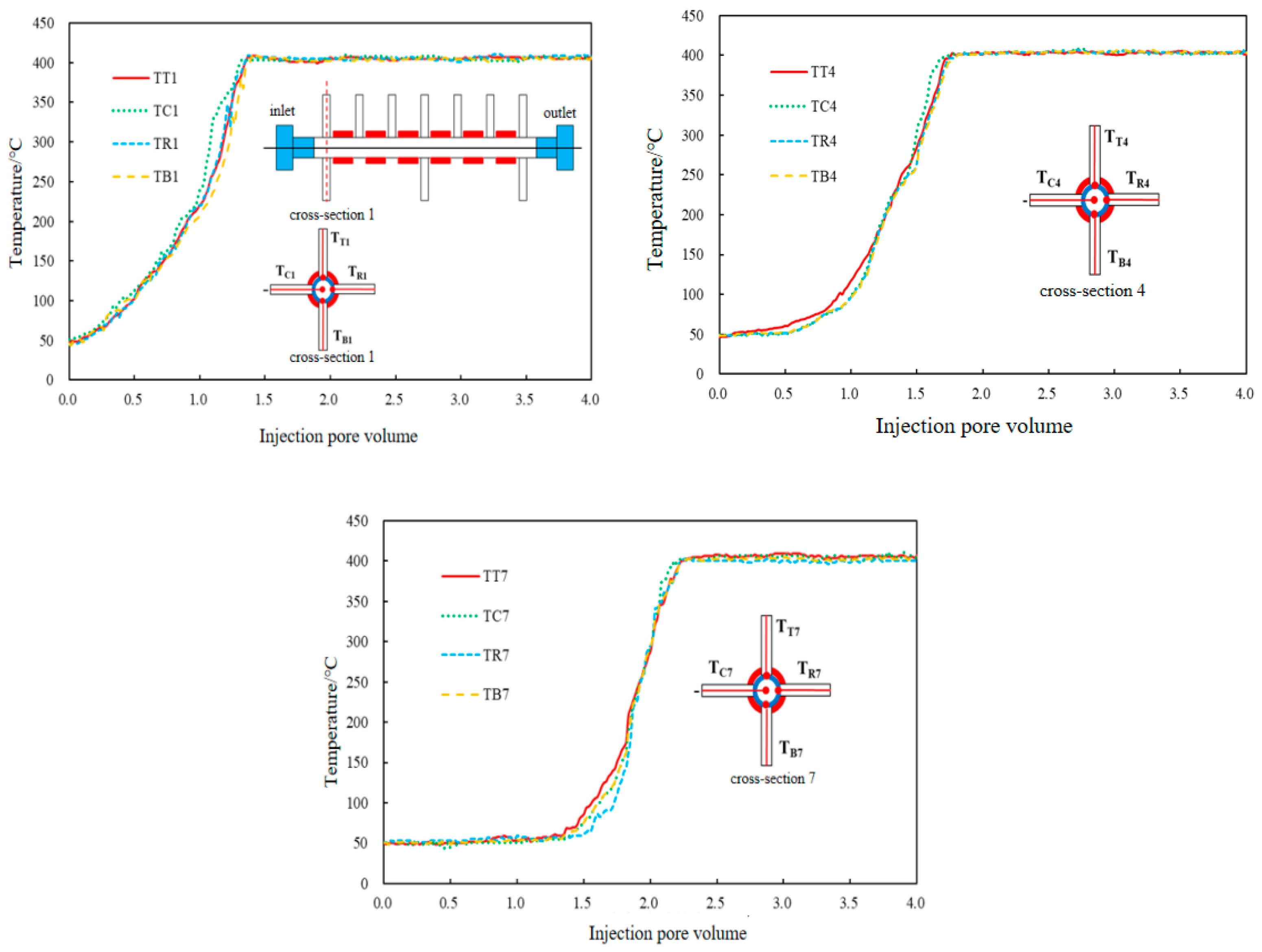
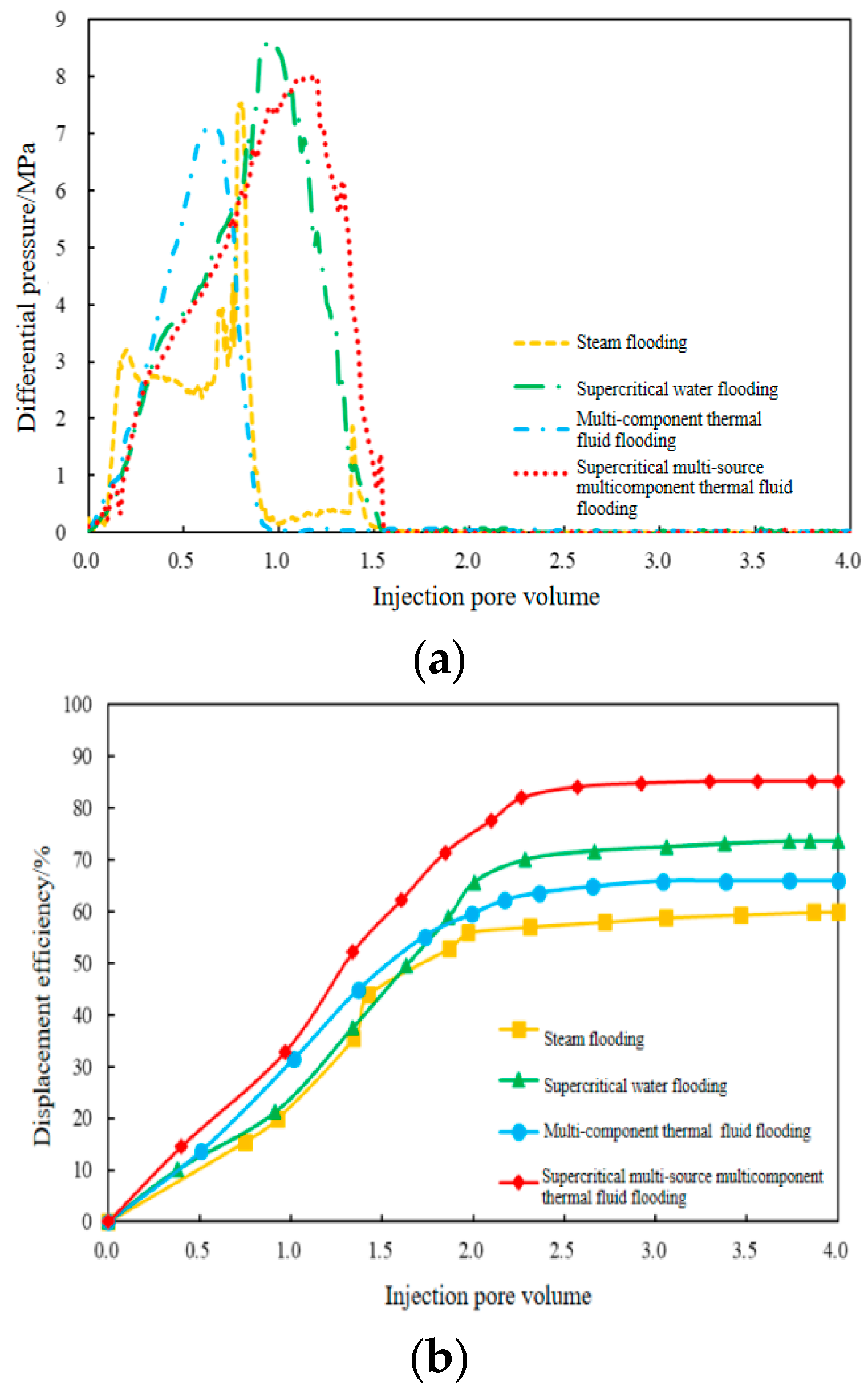
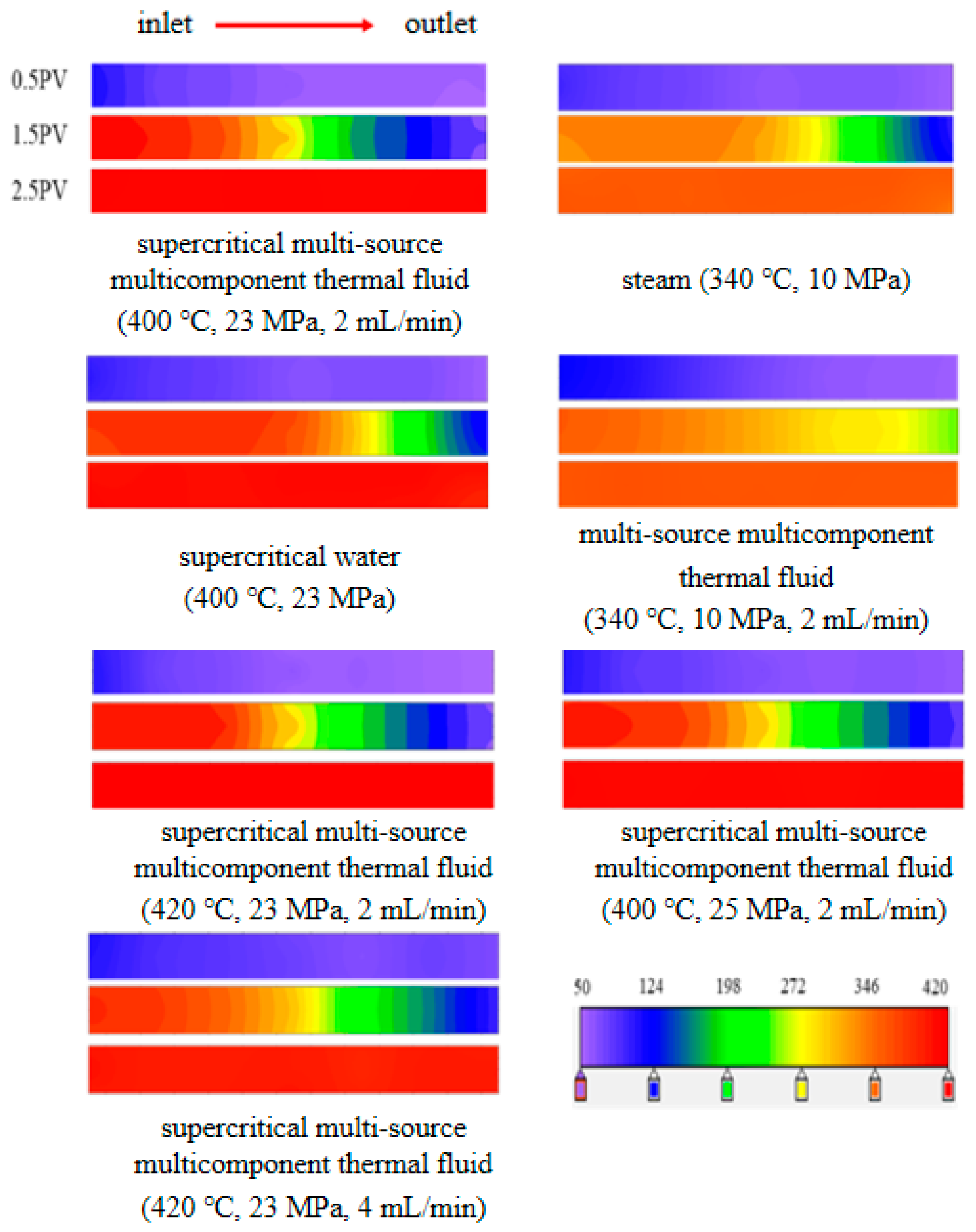

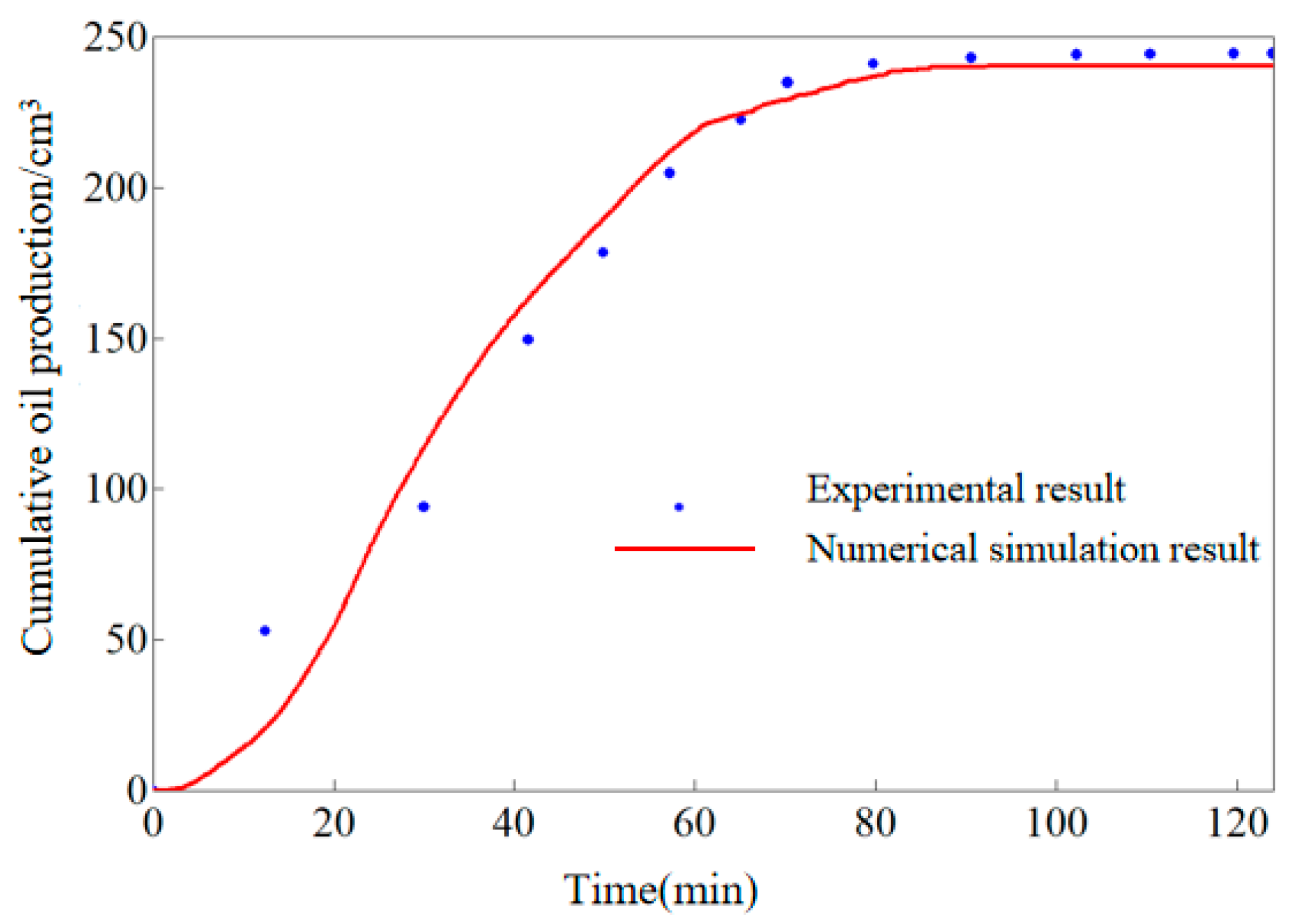

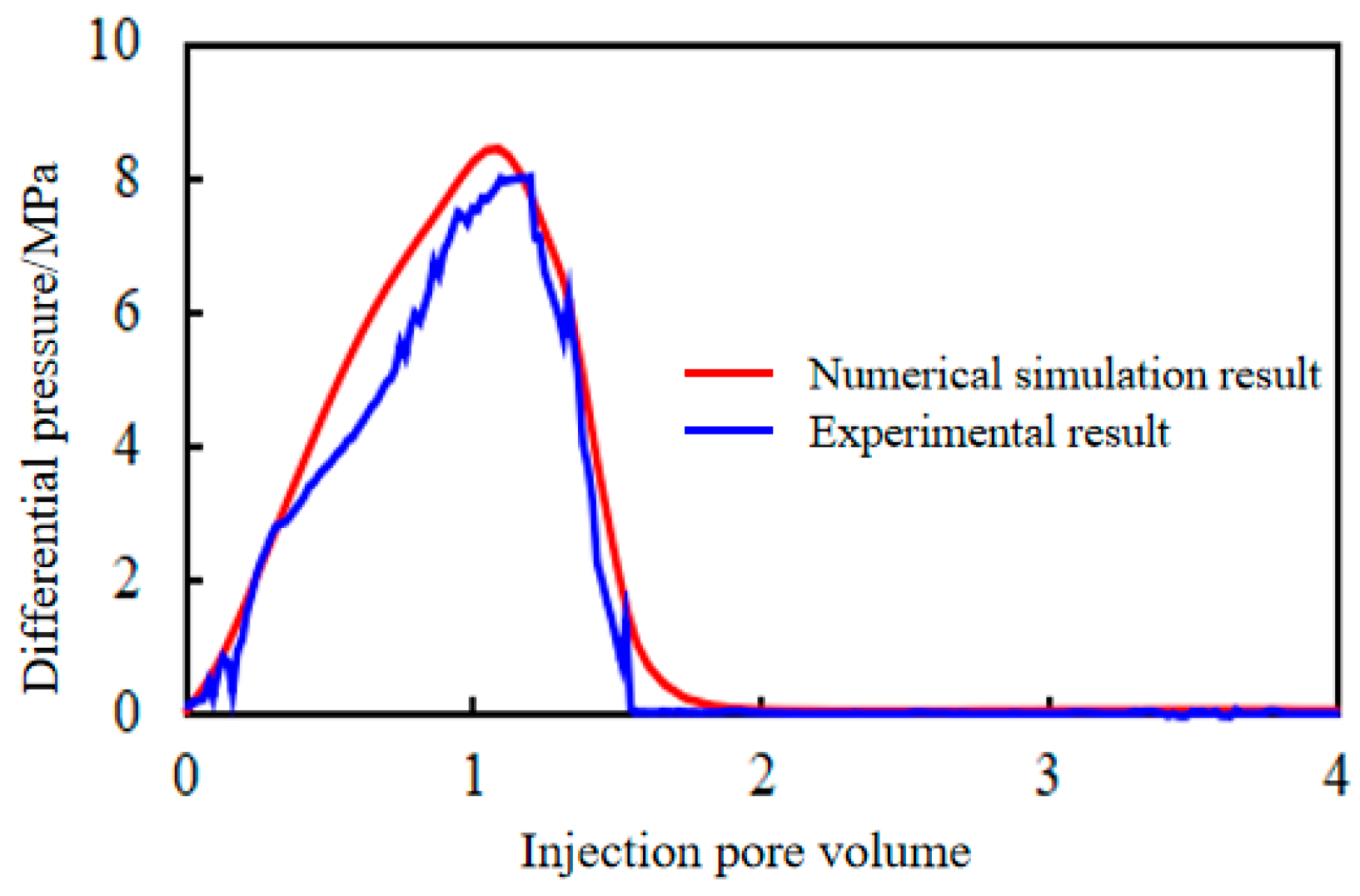

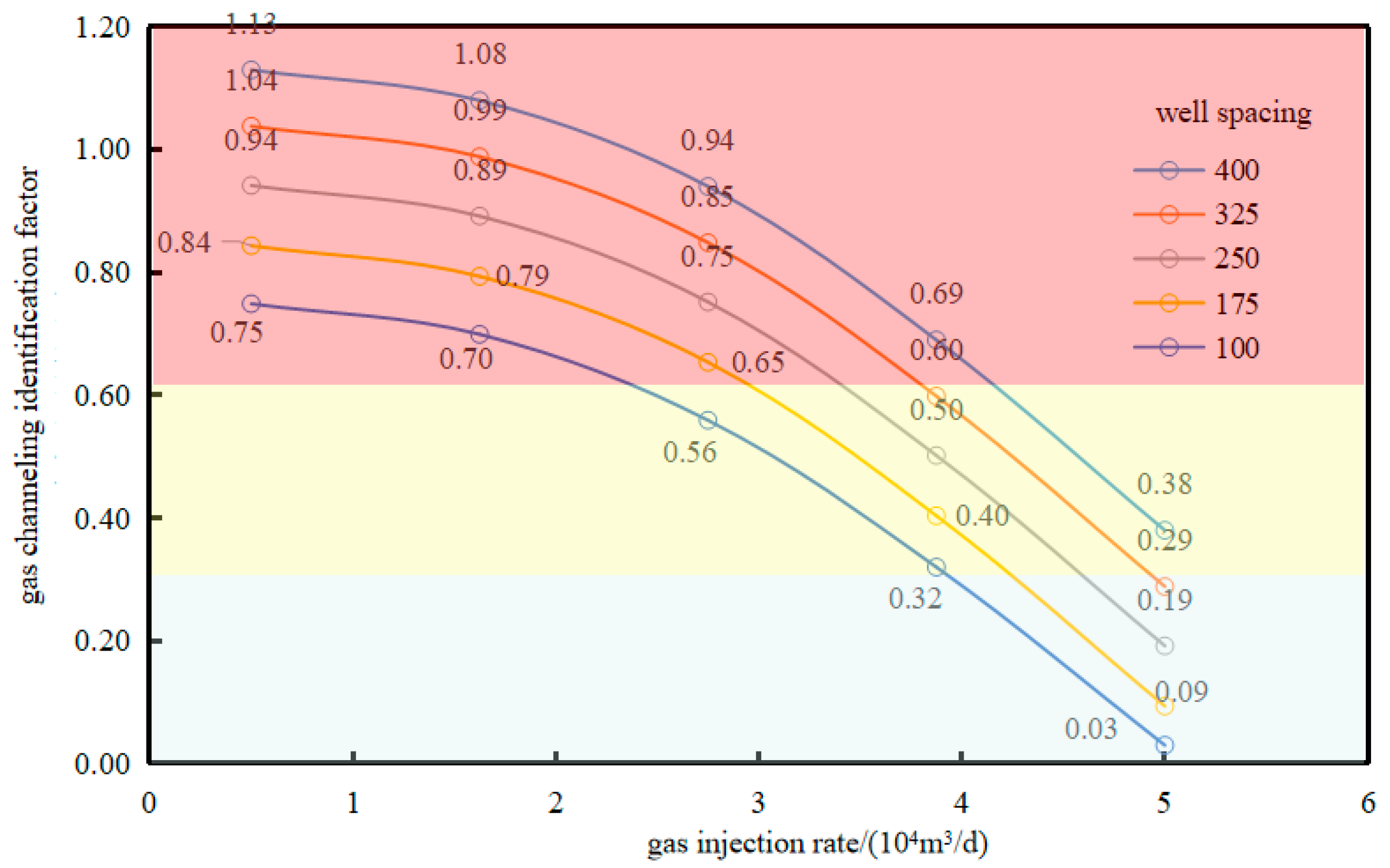
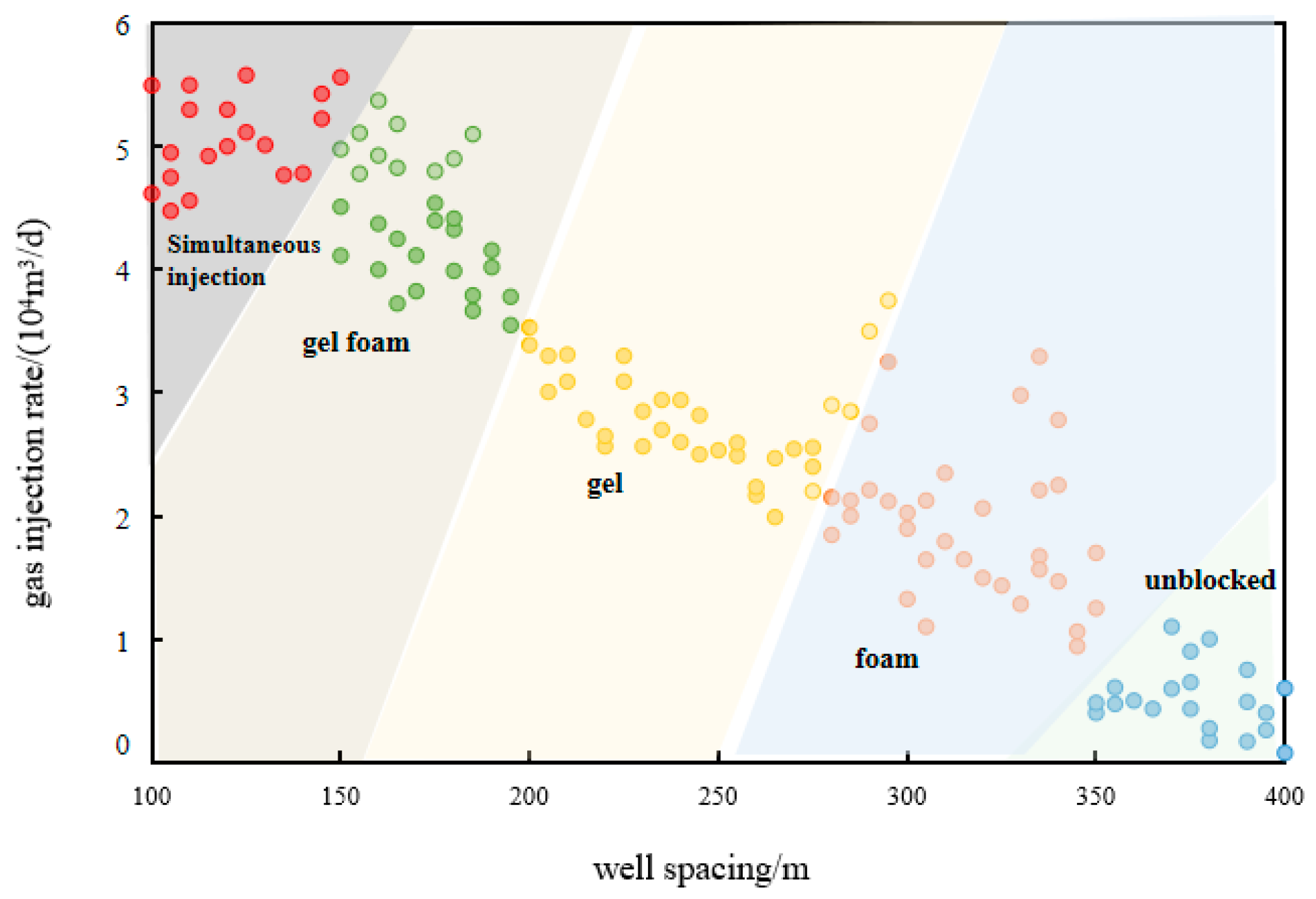
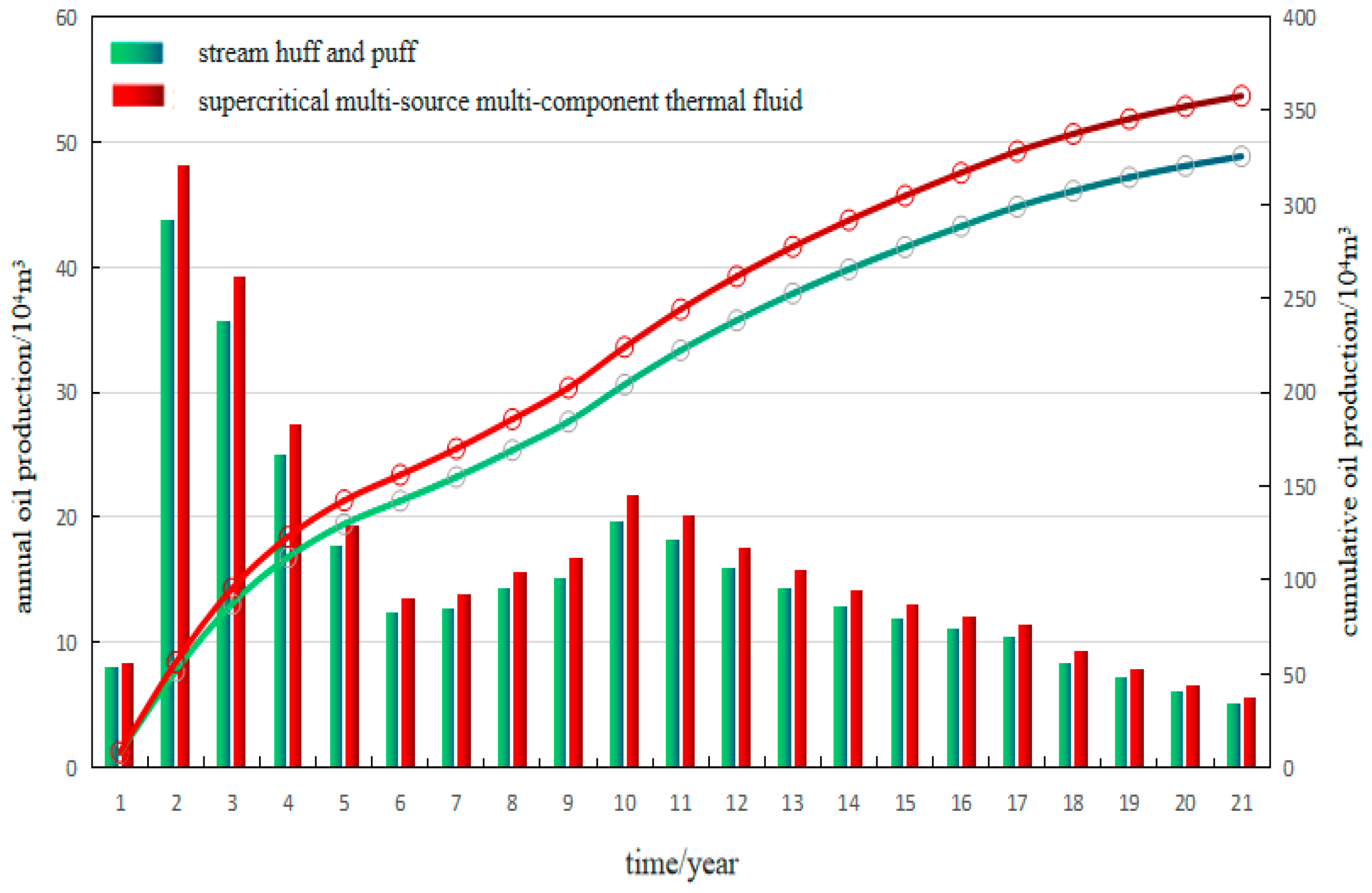
| Technology Type | Fuel | Water Quality Requirement | Enthalpy (kJ/kg) | Generating Equipment Thermal Efficiency |
|---|---|---|---|---|
| Supercritical multi-source multi-component thermal fluid | Heavy oil, crude oil, diesel oil, heavy oil production water | Production water or organic wastewater | 2867.33 (23 Mpaa, 400 °C) | No smoke loss, low generator temperature |
| Traditional multi-component thermal fluid | Diesel | High water quality requirements | 1401.41 (270 °C) | High generator temperature |
| Steam | Diesel or crude oil | High water quality requirements | 2385.05 (350 °C, steam quality 80%) | High generator temperature |
| Numbers | Injection Fluids | Injection Pressures | Injection Temperatures | Water Injection Rate | N2 Injection Rate | CO2 Injection Rate |
|---|---|---|---|---|---|---|
| 1 | steam | 10 MPa | 315 °C | 10 mL/min | 0 mL/min | 0 mL/min |
| 2 | steam | 12 MPa | 330 °C | 10 mL/min | 0 mL/min | 0 mL/min |
| 3 | steam | 14 MPa | 340 °C | 10 mL/min | 0 mL/min | 0 mL/min |
| 4 | supercritical water | 23 MPa | 400 °C | 10 mL/min | 0 mL/min | 0 mL/min |
| 5 | supercritical water | 23 MPa | 374 °C | 10 mL/min | 0 mL/min | 0 mL/min |
| 6 | supercritical water | 24 MPa | 400 °C | 10 mL/min | 0 mL/min | 0 mL/min |
| 7 | supercritical water + N2 | 23 MPa | 400 °C | 10 mL/min | 2 mL/min | 0 mL/min |
| 8 | supercritical water + N2 | 23 MPa | 374 °C | 10 mL/min | 2 mL/min | 0 mL/min |
| 9 | supercritical water + N2 | 24 MPa | 400 °C | 10 mL/min | 2 mL/min | 0 mL/min |
| 10 | supercritical water + CO2 | 23 MPa | 400 °C | 10 mL/min | 0 mL/min | 2 mL/min |
| 11 | supercritical water + CO2 | 23 MPa | 374 °C | 10 mL/min | 0 mL/min | 2 mL/min |
| 12 | supercritical water + CO2 | 24 MPa | 400 °C | 10 mL/min | 0 mL/min | 2 mL/min |
| 13 | Supercritical multi-source multi-component thermal fluid | 23 MPa | 400 °C | 10 mL/min | 1 mL/min | 1 mL/min |
| 14 | Supercritical multi-source multi-component thermal fluid | 23 MPa | 400 °C | 10 mL/min | 2 mL/min | 2 mL/min |
| 15 | Supercritical multi-source multi-component thermal fluid | 23 MPa | 420 °C | 10 mL/min | 1 mL/min | 1 mL/min |
| 16 | Supercritical multi-source multi-component thermal fluid | 25 MPa | 400 °C | 10 mL/min | 1 mL/min | 1 mL/min |
| Experimental Device Parameter | Index |
|---|---|
| Maximum working pressure | 35 Mpa |
| Maximum flow | 3 kg/h |
| Maximum temperature | 450 °C |
| Maximum superheat | >5 °C |
| Materials | Hastelloy |
| Coil length | 30 m |
| Experiment Number | 1 | 4 | 7 | 13 | 14 | 15 | 16 |
|---|---|---|---|---|---|---|---|
| Injected fluid | steam | Supercritical water | supercritical water + N2 | supercritical multi-source multi-component thermal fluid | supercritical multi-source multi-component thermal fluid | supercritical multi-source multi-component thermal fluid | supercritical multi-source multi-component thermal fluid |
| Inlet cross-section |  |  |  |  |  |  |  |
| Outlet cross-section |  |  |  |  |  |  |  |
| Number | Displacement Efficiency | Heat Utilization Rate | Number | Displacement Efficiency | Heat Utilization Rate |
|---|---|---|---|---|---|
| 1 | 59.87% | 0.0171 | 9 | 79.18% | 0.0245 |
| 2 | 61.85% | 0.0179 | 10 | 81.25% | 0.0252 |
| 3 | 62.97% | 0.0184 | 11 | 80.08% | 0.0255 |
| 4 | 73.48% | 0.0229 | 12 | 82.96% | 0.0260 |
| 5 | 70.22% | 0.0225 | 13 | 85.15% | 0.0267 |
| 6 | 75.03% | 0.0233 | 14 | 86.16% | 0.0262 |
| 7 | 78.52% | 0.0241 | 15 | 92.11% | 0.0276 |
| 8 | 76.96% | 0.0237 | 16 | 90.37% | 0.0274 |
| Parameters | Value |
|---|---|
| Reservoir pressure/MPa | 10 |
| Reservoir temperature/°C | 50 |
| Core porosity/% | 39 |
| Core permeability/mD | 2000 |
| Core oil saturation/% | 93.5 |
| Gas type | 15% CO2 + 85% N2 |
| Well type | Horizontal well |
| Reserve volume/104 m3 | 1025 |
| Injection mode | continuous injection |
| Number | Static Parameter | Value Range |
|---|---|---|
| 1 | Oil viscosity/mPa·s | 350~3000 |
| 2 | Permeability/mD | 300~5000 |
| 3 | Reservoir pressure/Mpa | 6.5~20 |
| 4 | Water multiple | 0.1~10 |
| 5 | Reservoir thickness/m | 6~40 |
| Number | Dynamic Parameter | Value Range |
|---|---|---|
| 1 | Periodic steam injection volume/m3 | 3000~7000 |
| 2 | Steam injection temperature/°C | 270~430 |
| 3 | Steam injection rate/(m3/d) | 90~330 |
| 4 | Gas-liquid ratio/(m3/m3) | 100~900 |
| 5 | Liquid production/m3 | 80~160 |
| Static Parameters | Sum of Squares | DOF | Mean Square | F | Significance |
|---|---|---|---|---|---|
| Oil viscosity | 0.812 | 4 | 0.203 | 0.200 | 0.926 |
| Permeability | 1.468 | 4 | 0.367 | 0.361 | 0.826 |
| Reservoir pressure | 30.803 | 4 | 7.701 | 7.573 | 0.038 |
| Water multiple | 1.314 | 4 | 0.328 | 0.323 | 0.850 |
| Net-to-gross ratio | 26.539 | 4 | 6.635 | 6.524 | 0.048 |
| Static Parameters | Sum of Squares | DOF | Mean Square | F | Significance |
|---|---|---|---|---|---|
| Oil viscosity | 14.587 | 4 | 3.647 | 6.074 | 0.054 |
| Permeability | 5.934 | 4 | 1.484 | 2.471 | 0.201 |
| Reservoir pressure | 15.996 | 4 | 3.999 | 6.661 | 0.047 |
| Water multiple | 10.139 | 4 | 2.535 | 4.222 | 0.096 |
| Net-to-gross ratio | 13.516 | 4 | 3.379 | 5.628 | 0.061 |
| Dynamic Parameters | Sum of Squares | DOF | Mean Square | F | Significance |
|---|---|---|---|---|---|
| Periodic steam injection volume | 1.612 | 4 | 0.403 | 22.094 | 0.005 |
| Steam injection temperature | 2.588 | 4 | 0.647 | 35.459 | 0.002 |
| Liquid production | 0.016 | 4 | 0.004 | 0.221 | 0.914 |
| Steam injection rate | 0.274 | 4 | 0.069 | 3.758 | 0.114 |
| Gas-liquid ratio | 0.26 | 4 | 0.065 | 3.56 | 0.123 |
| Dynamic Parameters | Sum of Squares | DOF | Mean Square | F | Significance |
|---|---|---|---|---|---|
| Periodic steam injection volume | 0.014 | 4 | 0.004 | 8.668 | 0.03 |
| Steam injection temperature | 0.017 | 4 | 0.004 | 10.038 | 0.023 |
| Liquid production | 0.004 | 4 | 0.001 | 2.232 | 0.228 |
| Steam injection rate | 0.009 | 4 | 0.002 | 5.177 | 0.07 |
| Gas-liquid ratio | 0.006 | 4 | 0.002 | 3.746 | 0.114 |
| Gas Channeling Degree | Gas Channeling Identification Factor | Maximum Daily Gas Injection 104 m3/d |
|---|---|---|
| / | 0.85~2.97 | 0~1.5 |
| Weak | 0.51~0.63 | 0.75~1.5 |
| Medium | 0.40~0.60 | 1.5~3.0 |
| Strong | <0.40 | >3.0 |
| Oil Field | Reservoir Thickness/m | Reservoir Pressure/MPa | Water Energy/times | Reservoir Permeability/mD | Oil Viscosity/cP |
|---|---|---|---|---|---|
| LD 21-2 IV oil group | 40 | 15.3 | 10 | 1966 | 2980 |
| PL19-3 11/13 area | 25 | 12 | 2 | 1161 | 438 |
| KL 10-2 | 8 | 13 | 1 | 3000 | 935 |
| QHD 27-3 | 7 | 10.6 | 1 | 4000 | 440 |
| LD 27-2 | 8 | 13.1 | 0.1 | 2300 | 1383 |
| NB 35-2 | 8 | 8.5 | 5 | 4600 | 707 |
| PL 13-2 | 8.3 | 11 | 0 | 1957 | 661 |
| LD 27-1 | 8 | 11.8 | 0 | 1600 | 1038 |
| JX 1-1 | 10 | 11.6 | 5 | 1000 | 593 |
| QHD 33-1S | 5 | 10.6 | 1 | 2078 | 750 |
| KL 9-5 | 10 | 10 | 10 | 1726 | 910 |
| LD 32-2 | 15 | 12.1 | 60 | 3130 | 498 |
| Rank | Single Sand Body Oil Field | y Value |
|---|---|---|
| 1 | LD 21-2 IV oil group | 14.74 |
| 2 | PL19-3 11/13 area | 12.74 |
| 3 | LD 16-3 | 12.19 |
| 4 | KL 10-2 | 10.60 |
| 5 | QHD 27-3 | 10.49 |
| 6 | LD 27-2 | 9.65 |
| 7 | NB 35-2 | 9.34 |
| 8 | PL 13-2 | 9.14 |
| 9 | LD 27-1 | 8.77 |
| Rank | Single Sand Body Oil Field | y Value |
|---|---|---|
| 1 | LD 21-2 IV oil group | 5.33 |
| 2 | PL19-3 11/13 area | 4.91 |
| 3 | QHD 27-3 | 4.54 |
| 4 | KL 10-2 | 4.45 |
| 5 | NB 35-2 | 4.23 |
| 6 | LD 32-2 | 4.07 |
| 7 | LD 27-2 | 4.03 |
| 8 | PL 13-2 | 3.90 |
| Evaluation Parameters | Value |
|---|---|
| Well-controlled reserves | 500,000 cubic meters |
| Development mode | Supercritical fluid after cooling and depressurization |
| Mechanical mining method | Integrated injection-production string |
| Single platform development investment | 65 million yuan |
| Single well drilling and completion investment | 40 million yuan |
| Operating cost per well cycle | 5 million yuan |
| Evaluation Parameters | Value |
|---|---|
| Horizontal well length | 400 m |
| Development mode | Multi-component thermal fluid/Steam huff and puff/Supercritical fluid after cooling and depressurization |
| Mechanical mining method | Integrated injection-production string |
| Investment in engineering facilities | 140 million yuan |
| Average investment per well | 15 million yuan |
| Operating cost per well cycle | 5 million yuan |
| Number | Reservoir/Fluid Parameters | Screening Criteria | |
|---|---|---|---|
| Potential Tapping Development | Developing Relying on Other Developing Oilfield | ||
| 1 | Reserve scale/104 m3 | ≥500 | ≥1400 |
| 2 | Reservoir buried depth/m | ≥1000 | ≥600 |
| 3 | Reservoir pressure/MPa | ≥10 | ≥6 |
| 4 | Reservoir thickness/m | single layer 10 multi-layer/thick layer30 | single layer ≥ 5 transitional zone ≥ 20 multi-layer/thick layer ≥ 25 |
| 5 | NTG | ≥0.6 | ≥0.6 |
| 6 | Gas channeling identification factor | ≥0.6 | ≥0.6 |
| 7 | Vertical permeability ratio | 0.05~0.4 | 0.05~0.4 |
| 8 | Water energy | pure oil region ≤ 10 | pure oil region ≤ 20 transitional zone ≤ 5 |
| 9 | Permeability/mD | ≥1000 | ≥500 |
| 10 | Oil viscosity/cP | ≥500 | ≥300 |
Disclaimer/Publisher’s Note: The statements, opinions and data contained in all publications are solely those of the individual author(s) and contributor(s) and not of MDPI and/or the editor(s). MDPI and/or the editor(s) disclaim responsibility for any injury to people or property resulting from any ideas, methods, instructions or products referred to in the content. |
© 2024 by the authors. Licensee MDPI, Basel, Switzerland. This article is an open access article distributed under the terms and conditions of the Creative Commons Attribution (CC BY) license (https://creativecommons.org/licenses/by/4.0/).
Share and Cite
Sun, Y.; Zhang, L.; Bai, Y.; Wang, T.; Zhang, W.; Zhang, J.; Liu, P. Analysis of Adaptability and Application Potential of Supercritical Multi-Source Multi-Component Thermal Fluid Technology for Offshore Heavy Oil in China. Appl. Sci. 2024, 14, 3588. https://doi.org/10.3390/app14093588
Sun Y, Zhang L, Bai Y, Wang T, Zhang W, Zhang J, Liu P. Analysis of Adaptability and Application Potential of Supercritical Multi-Source Multi-Component Thermal Fluid Technology for Offshore Heavy Oil in China. Applied Sciences. 2024; 14(9):3588. https://doi.org/10.3390/app14093588
Chicago/Turabian StyleSun, Yan, Lijun Zhang, Yuting Bai, Taichao Wang, Wenbo Zhang, Jipeng Zhang, and Pengcheng Liu. 2024. "Analysis of Adaptability and Application Potential of Supercritical Multi-Source Multi-Component Thermal Fluid Technology for Offshore Heavy Oil in China" Applied Sciences 14, no. 9: 3588. https://doi.org/10.3390/app14093588





